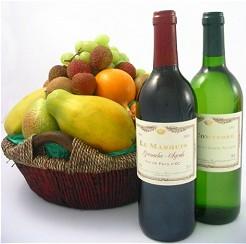
The procedure below outlines how to make wine out of pineapple. This procedure can also be applied in making wine from other fruits such as cashew, duhat, bignay, melon, siniguelas, among others.
PINEAPPLE WINE
Procedure:
1. Wash and peel sound mature fruits. Waste core and trimmings from pineapple canning operation can be utilized for wine making.
2. Crush the peeled fruit and press well to extract the juice and strain through a cheesecloth or strainer.
3. To one part of the juice, add two to three parts of water. For every four (4) cups of diluted juice, add one cup sugar.
4. Mix well to dissolve the sugar and heat for 30 minutes to pasteurize. Cool. Add one (1) teaspoon yeast for every 18 cups of the juice mixture.
5. Pour the mixture into a demijohn or any suitable container. Loose stopper the mouth of the container with cotton and store in a safe place.
6. Let it ferment for two (2) or more weeks until there is no more liberation of bubbles.
7. After fermentation, pasteurize then decant the clear liquid into any suitable container and age 2 to 3 months or more.
8. To the aged wine, add well beaten egg white (1 for every 12 cups) and heat in a steam bath to a temperature of 55°C or 60°C to clarify or remove the turbidity of the wine. Stir and maintain the temperature for 15 to 20 minutes then cool.
Source: ITDI, photo from: orders.mkn.co.uk/fruit/express/7fruitwine
PINEAPPLE WINE
Procedure:
1. Wash and peel sound mature fruits. Waste core and trimmings from pineapple canning operation can be utilized for wine making.
2. Crush the peeled fruit and press well to extract the juice and strain through a cheesecloth or strainer.
3. To one part of the juice, add two to three parts of water. For every four (4) cups of diluted juice, add one cup sugar.
4. Mix well to dissolve the sugar and heat for 30 minutes to pasteurize. Cool. Add one (1) teaspoon yeast for every 18 cups of the juice mixture.
5. Pour the mixture into a demijohn or any suitable container. Loose stopper the mouth of the container with cotton and store in a safe place.
6. Let it ferment for two (2) or more weeks until there is no more liberation of bubbles.
7. After fermentation, pasteurize then decant the clear liquid into any suitable container and age 2 to 3 months or more.
8. To the aged wine, add well beaten egg white (1 for every 12 cups) and heat in a steam bath to a temperature of 55°C or 60°C to clarify or remove the turbidity of the wine. Stir and maintain the temperature for 15 to 20 minutes then cool.
Source: ITDI, photo from: orders.mkn.co.uk/fruit/express/7fruitwine

No comments:
Post a Comment